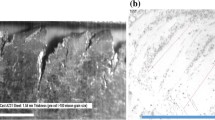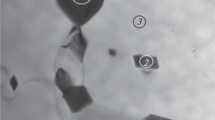Abstract
Magnesium alloys show promise for application in formed components where weight saving is an advantage. In most instances forming is carried out at elevated temperatures. However, there are considerable gains to be had if forming can be carried out under ambient conditions. The present article outlines some of the difficulties that lie in the way of achieving this objective. The underlying metallurgical characteristics of the issues are considered and means for overcoming them are discussed. It is concluded that a combination of microstructure and texture control remains a promising strategy.
Similar content being viewed by others
References
E.F. Emley, Principles of Magnesium Technology (Oxford: Pergamon Press, 1966).
M. Avedesian and H. Baker, editors, ASM Specialty Handbook Magnesium and Magnesium Alloys (Materials Park, OH: ASM International, 1999).
W.F. Hosford, The Mechanics of Crystals and Textured Polycrystals (New York: Oxford University Press, 1993), pp. 163–192.
M.H. Yoo, Metallurgical Transactions A, 12 (1981), pp. 409–418.
M.R. Barnett, Materials Science and Engineering A, 464(1–2) (2007), pp. 8–16.
T. Mukai et al., Scripta Materialia, 45(1) (2001), pp. 89–94.
S.R. Agnew et al., Scripta Materialia, 50(3) (2004), pp. 377–381.
Y.N. Wang and J.C. Huang, Materials Chemistry and Physics, 81(1) (2003), pp. 11–26.
F.E. Hauser, P.R. Landon, and J.E. Dorn, Transactions of the American Society of Metals, 50 (1958), pp. 856–883.
J.C. McDonald, Transactions of the Metallurgical Society of AIME, 137 (1940), pp. 430–441.
W.J. Kim and H.T. Jeong, Materials Transactions, 46 (2005), pp. 251–258.
M.R. Barnett, Materials Science and Engineering A, 464(1–2) (2007), pp. 1–7.
K. Iwanaga et al., Journal of Materials Processing Technology, 155–156 (2004), pp. 1313–1316.
A.G. Beer, “The Evolution of Hot Working Stress and Microstructure in Mg-3Al-1Zn” (Ph.D. Thesis, Deakin University, Geelong, Australia, 2004).
E.A. Ball and B. Prangnell, Scripta Metallurgica et Materialia, 31(2) (1994), pp. 111–116.
J.A. Chapman and D.V. Wilson, Journal of the Institute of Metals, 91 (1962), pp. 39–40.
D.V. Wilson and J.A. Chapman, Philosophical Magazine, 8 (1963), pp. 1543–1551.
R.W. Armstrong, “Tensile Ductility Dependence on Polycrystal Grain Size,” 7th International Conference on the Strength of Metals and Alloys, ICSMA-7-CIRMA, ed. H.J. McQueen et al. (Oxford: Pergamon Press, 1986), pp. 195–200.
S.H. Kang, Y.S. Lee, and J.H. Lee, Journal of Materials Processing Technology, 201(1–3) (2008), pp. 436–440.
M. Kai, Z. Horita, and T.G. Langdon, Materials Sc.ience and Engineering A, 488(1–2) (2008), pp. 117–124.
M.T. Pérez-Prado et al., Scripta Materialia, 50(5) (2004), pp. 661–665.
N. Stanford and M.R. Barnett, Journal of Alloys and Compounds, 466(1–2) (2008), pp. 182–188.
J. Bohlen et al., Acta Materialia, 55(6) (2007), pp. 2101–2112.
N. Stanford and M.R. Barnett, Materials Science and Engineering: A, 496 (2008), pp. 399–408.
N. Stanford et al., Scripta Materialia, 59(7) (2008), pp. 772–775.
L.W.F. Mackenzie and M.O. Pekguleryuz, Scripta Materialia, 59(6) (2008), pp. 665–668.
A. Ahmadieh, J. Mitchell, and J.E. Dorn, Transactions of the Metallurgical Society of AIME, 233 (1965), pp. 1130–1138.
S.M. Zhu and J.F. Nie, Scripta Materialia, 50(1) (2004), pp. 51–55.
S.L. Semiatin and J.J. Jonas, Formability & Workability of Metals (Metals Park, OH: ASM, 1984), p. 165.
M.R. Barnett, Scripta Materialia, 59(7) (2008), pp. 696–698.
P. Cizek and M.R. Barnett, Scripta Materialia, 59(9) (2008), pp. 959–962.
Author information
Authors and Affiliations
Corresponding author
Rights and permissions
About this article
Cite this article
Barnett, M.R., Stanford, N., Cizek, P. et al. Deformation mechanisms in Mg alloys and the challenge of extending room-temperature plasticity. JOM 61, 19–24 (2009). https://doi.org/10.1007/s11837-009-0115-6
Published:
Issue Date:
DOI: https://doi.org/10.1007/s11837-009-0115-6




